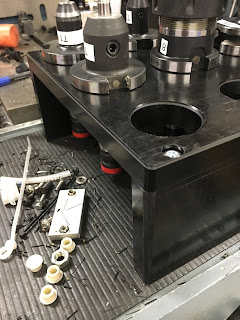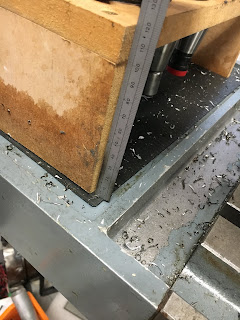Yes, I did my last proper machining on The Shiz back in late April (27th) when I finished off the Z axis yoke. Since then I've been focusing on finishing off the Bridgeport conversion and in the event it hasn't required any further CNC work yet.
So when I came to flashing up The Shiz today, I hit a brick wall again. Last time round (a couple of weeks ago) it was down to some changes in the Windows Defender Firewall preventing the PC ("CNC12") talking to the Acorn (Beagle Bone Green). Everything else seemed to be working fine. This issue only became apparent when I actually tried to power up the spindle. I was planning on manually drilling out the 8 fixing holes (counterbored M6, to take cap head bolts) as a cunning way of holding the stock down, as otherwise it was looking a little tricky. But when I tried to turn the spindle on, I got a "probe present" type error. This is to prevent the Stupid Fat Bloke accidentally spinning the spindle with the Renishaw probe fitted, which wouldn't end well.
Sure enough, although I'd tried out many of the functions such as the tool setting and probing functions when I was getting the new 4.12 release back up to a working state, it's clear that I hadn't actually tried cutting air, as in spinning any sort of tool, even an imaginary one.
The most obvious issue is the function that uses the probe detect input to inhibit the spindle. Sounds simple enough but the various / myriad inputs are gated together in a mysterious and undocumented fashion. The partial documentation that does exist only gives away part of the workings and to be honest I'm not convinced anybody at Centroid fully understands it. I suspect the originators have left / died / forgotten how it is constructed, so each time they go in to make changes it becomes more and more fraught.
Last time (back in April) I posted what I thought to be the definitive config on the Centroid forum, this is what I said:
Inputs and settings:
* Renishaw probe trigger goes to input 4. Described as "Unused" and "NC" in the wizard. It's normally closed, so contact opens the switch and the input is pulled up to 24V.
* Renishaw probe detect goes to input 6. Described as "ProbeDetect" and "NC" in the wizard. It's a simple loop to ground inside the plug.
* TT trigger signal goes to input 7. Described as "ProbeTripped" and "NO" in the wizard. My probe is also a normally closed electrical switch, so contact with the tool lets the input signal go up to 24V.
Parameter settings:
* # 11 is "-4" (TT to input 4, the sign indicates the type of input, NC or NO)
* # 12 is "10" (the tool number of the Renishaw probe in the library)
* # 17 is "3" on my machine (represents "G30 P3" command). The P3 coords are stored in the WCS table / return table. The coordinates define the position of my (fixed) TT. It rapids there before doing tool measurement with the TT.
* # 18 IS NOW "-6" (changed in 4.12). The input that is checked to see if a probe is connected. If so, the spindle is inhibited.) NB: You should also set #257.
* # 257 is "+6". Yes, NOW POSITIVE six (changed in 4.12). "Tool touchoff detect". Parameter #18 requires this test for the Renishaw probe but you have to fool it for the TT probe.
* #43 is 2 ("use #44 defined input for TT")
* #44 is 7 (TT input channel number)
It's now clear that some of this is bollocks (given that the spindle won't even turn) and looking at it, anyone can see the description of parameter # 257 is wrong. What a dork.
After that half-arsed attempt to show how to get a TT and probe to co-exist on an Acorn system, a guy called swissi made a decent pass at it in September. His notes tell you how to correctly choose the options within the Centroid Setup Wizard to get the required config setup. I have to say that even after following that carefully, it still didn't work. Finally, I managed to figure out and frig the required changes.
This is actually the correct config:
Inputs and settings:
* Renishaw probe trigger goes to input 4. Described as "Unused" and "NC" in the wizard. It's normally closed, so contact opens the switch and the input is pulled up to 24V.
* Renishaw probe detect goes to input 6. Described as "ProbeDetect" and "NC" in the wizard. It's a simple loop to ground inside the plug.
* TT trigger signal goes to input 7. Described as "ProbeTripped" and "NC" in the wizard. My probe is also a normally closed electrical switch, so contact with the tool lets the input signal go up to 24V.
Parameter settings:
* # 11 is "-4" (TT to input 4, the sign indicates the type of input, NC or NO)
* # 12 is "10" (the tool number of the Renishaw probe in the library)
* # 17 is "3" on my machine (represents "G30 P3" command). The P3 coords are stored in the WCS table / return table. The coordinates define the position of my (fixed) TT. It rapids there before doing tool measurement with the TT.
* # 18 IS NOW "+6" (changed in 4.12). The input that is checked to see if a probe is connected. If so, the spindle is inhibited.)
* # 257 is "+7". Yes, NOW POSITIVE seven (changed in 4.12). "Tool touchoff detect".
* #43 is 2 ("use #44 defined input for TT")
* #44 is -7 (TT input channel number)
I suspect the issue was around parameter #18, as the other changes relate to the TT (tool setting) probe.
But what a wanker getting that wrong - and not even noticing it for 6+ months. So now I've actually tested:
- Tool setter / tool offset measurement works with the TT.
- Part probing works with the Renishaw probe.
- Probing won't start without the probe fitted.
- Spindle won't turn with probe plugged in.
- Spindle actually turns when told to(!)
And I've created a backup file ("report") so I can revert again if anything screws up ie The Stupid Fat Bloke gets his podgey fingers on the config.
I thought for a moment that I no longer neededed to plug in the dummy connector when the probe tool is not plugged in but that turned out to be optimistic. Leaving the dummy unplugged prevents fast jogging and also stops MDI moves. Doh.
What a waste of time - about 4 hours or so trying to recall the whole sorry saga, then attempting to fix the problem. But at least now I may be able to do some hole drilling....




























































